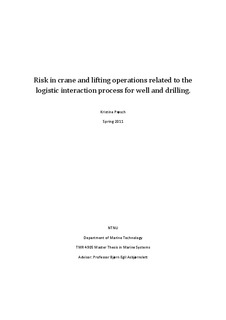| dc.description.abstract | This master thesis compares the logistic chain of operations and maintenance versus drilling and well and finds how drilling and well affect this chain with regards to risk on crane and lifting operations. Research has been done through accident/incident analysis, statistic, observations and interviews. An influence diagram for frequency is made, to better understanding the risk influencing factors (RIF) that affects a crane and lifting operation. The influence diagram is based on operational-, organisational-, and authority- and customer related risk influencing factors. These factors describe general causes and actors influencing the risk for frequency or consequence of a crane- and lifting operation accident.
The risk influencing factors is modelled in a Bayesian Network (BN) to see how they affect the severity of incidents. To make the BN the program GenIE is used, this is a very useful program to model risk, but can be a bit complicated with regards to many influencing factors and many levels of the factor.
From investigation of the logistic chain, incidents/accidents and statistics there was found:
Underlying causes:
Simulation and practice 38.5%Operators maintenance organisation 14%Coordination and planning 24.6%Operations, procedures and support 23%
Direct causes:
Human factors 35%Operational working conditions 29%Compliance 27%Physical/environmentally conditions 9
Incident:
Green 96,93%Yellow 1,43%Red 1,64
When situations are at high risk (red), precautions must be taken straight away. The analysis shows that it will be most efficient to improve coordination and planning; the underlying case is reflected in all the direct causes and will affect all of them in a positive way.
Some measurements will affect coordination and planning easily.
A lot of misunderstandings could have been avoided if everyone had been using the same technical system, SAP, for ordering and planning. To achieve this goal everyone must learn how to use the system, and use the same part of it. A group of planners from each unit should meet once a day and work together to make one plan and inform each other about changes.For the supply vessel and installation it would have been much easier if every documentation and certification were online, this could make their planning process much easier. Then plans of where the goods should be placed could be done before the vessel enters at the supply base and the installation would have had time to prepare better for reception of the supply vessel. This should be quite easy to implement since all goods should already have a serial number in SAP:The milling machine at the installations would also make things much easier, because then not so many containers would need to be shipped to the installations and space and money would be saved. | nb_NO |
